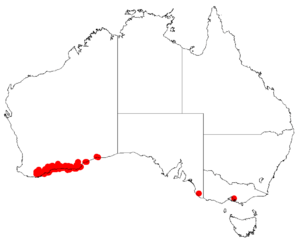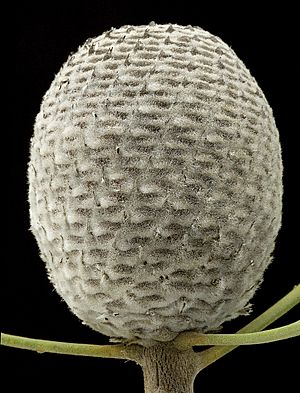Barrel coneflower facts for kids
Quick facts for kids Barrel coneflower |
|
|---|---|
 |
|
| Flower head of Isopogon trilobus | |
| Scientific classification | |
| Genus: |
Isopogon
|
| Species: |
trilobus
|
 |
|
| Occurrence data from Australasian Virtual Herbarium | |
| Synonyms | |
|
|
The barrel coneflower, also known as Isopogon trilobus, is a special type of flowering plant. It belongs to the Proteaceae family, which includes many unique Australian plants. This shrub is found only in the southern coastal areas of Western Australia. It has interesting wedge-shaped leaves that are lobed or toothed. Its flowers are cream-coloured to yellow and grow in oval, round, or barrel-shaped heads.
Contents
What Does Barrel Coneflower Look Like?
The barrel coneflower grows as a shrub. It can be anywhere from 30 cm (0.98 ft) tall to 2 m (6.6 ft) high. When new stems grow, they are light to reddish-brown. They start with tiny hairs but later become smooth.
Leaves and Flowers
The leaves of this plant are about 40–70 mm (1.6–2.8 in) long. They usually have three to nine teeth or three to five deep lobes. Each tooth or lobe has a sharp point at its end.
The flowers grow at the tips of the branches. They form oval, round, or barrel-shaped heads that are about 25–30 mm (0.98–1.18 in) wide. At the bottom of these flower heads are hairy, egg-shaped leaves called involucral bracts. The flowers themselves are silky and hairy. They are cream-coloured to yellow and measure about 8–10 mm (0.31–0.39 in) long.
When It Blooms and Fruits
Barrel coneflowers bloom from September to December. After flowering, the plant produces fruit. The fruit is a hairy, oval nut. Many of these nuts join together to form a barrel-shaped head, which is about 28 mm (1.1 in) across. This is how the plant gets its common name, "barrel coneflower"!
Naming the Barrel Coneflower
The barrel coneflower was first officially described in 1810. A botanist named Robert Brown gave it the scientific name Isopogon trilobus. He published his description in a scientific paper called Transactions of the Linnean Society.
What Its Name Means
The second part of its scientific name, trilobus, comes from Latin words. "Tri-" means "three," and "lobus" means "lobe." This name refers to the plant's leaves, which often have three lobes. Another name Brown used later, tripartitus, means "divided into three parts." This also refers to the plant's unique leaves.
Where Barrel Coneflower Grows
The barrel coneflower is found in many places along the southern coast of Western Australia. You can see it from the Stirling Range all the way east to Israelite Bay.
Its Favorite Places to Live
This plant likes to grow in sandy areas, such as sandplains and dunes. It can also be found on rocky outcrops. It prefers sandy soils, sometimes with a type of soil called laterite underneath. It grows in plant communities known as heathland or shrubland.
Who Visits the Flowers?
Some types of bees like to visit the flowers of the barrel coneflower. Two specific kinds of bees have been seen on its flowerheads:
- The colletid bee called Hylaeus sanguinipictus
- The halictid bee known as Lasioglossum caesium
These bees help the plant by carrying pollen from one flower to another, which helps the plant make seeds.
Growing Barrel Coneflower in Gardens
If you want to grow a barrel coneflower, there are a few things to know. This plant is sensitive to a plant disease called Phytophthora cinnamomi dieback. This means it needs very good drainage in the soil. It also needs lots of sunlight.
It probably won't do well in places with very humid weather. However, if you graft it onto other Isopogon species, like I.anethifolius or I.dawsonii, it might be able to grow in more different climates. People like to grow it because it has a dense, bushy shape and produces large, interesting fruits.
Images for kids



